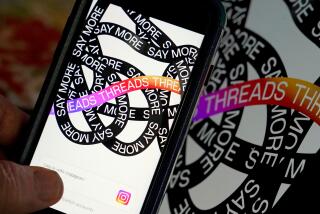Twitter IPO hurdle: The service is well known but not widely used
SAN FRANCISCO — By all rights, Twitter should be wildly popular with mainstream America.
World leaders, the pope, even Justin Bieber post updates there.
It tells us what’s culturally relevant at any given moment, be it Beyonce’s performance at the Super Bowl and the blackout in the New Orleans Superdome or Syfy channel’s campy made-for-TV movie “Sharknado” about a tornado teeming with sharks.
But Twitter doesn’t have nearly the following most people think it has.
Twitter will reveal for the first time in a year how many users it has when it makes public its stealth filing for an initial public offering as soon as this week.
As of last December, Twitter said it had 200 million people using the service, with most of those accounts overseas, nowhere near the following of Facebook with 1.2 billion users, or Yahoo, with 800 million. Recent reports estimate that Twitter users have increased to about 240 million.
In the U.S., its audience is far smaller. According to research firm ComScore Inc., Twitter had nearly 62.3 million unique visitors in August, up from 55.5 million in February.
The reason: Most people know what Twitter is, but many don’t know how or why they should use it. Search for “I don’t get Twitter” and Google spits out 5.7 billion results.
Now that it is on the verge of selling its stock to the public, Twitter has to prove to investors it can broaden its appeal or risk being pigeonholed as a niche service, analysts say.
“User base and growth have not been a problem to date, but Twitter is going to have to find a good system to reach tomorrow’s Twitter users or eventually it will be a problem,” said Max Wolff, chief economist and senior equity analyst at Greencrest Capital.
The Twitter IPO has captured the public imagination because Twitter has become such an integral part of popular culture.
It’s a real-time spin room for politicians, an organizing tool for government protests, a wire service for breaking news and an online hangout to talk about live events and television shows.
Even its unusual conventions have saturated popular culture. Hashtags, a way of using a word to group tweets by subject, are on movie billboards and television ads. And “tweet” no longer just means the chirping of birds in the Oxford English Dictionary.
But Twitter executives have acknowledged for years that the service is not as welcoming as it should be.
“We have a lot of mainstream awareness, but mainstream relevancy is still a challenge,” Twitter co-founder Jack Dorsey told students at Columbia University’s Graduate School of Journalism in 2011.
Twitter has experimented with ways to make the service simpler and more personal as it faces rising competition from newer services such as Instagram and Ask.fm that resonate with younger audiences. It has also hired a former Google executive to spearhead overseas growth.
Still, it suffers from churn. People referred to as “Twitter quitters” get curious and try the service but then bail.
“Twitter is facing this dilemma as it struggles to get past a quarter billion users: Its growth is directly tied to what the public understands about what it is and how they can incorporate Twitter into their daily lives and get value out of it,” said Brian Solis, an analyst with Altimeter Group. “But I don’t even know if two or three Twitter employees would give you the same answer about what Twitter is.”
Celebrities, politicians, media personalities, authors and other public figures have embraced Twitter, drawn to the ability to instantly publish and connect with followers. Some have turned their Twitter followings into digital gold. Tween heartthrob Bieber, for instance, has more than 45 million followers on the service.
But the torrential stream of updates, with the most recent at the top — not necessarily the most important — can overwhelm beginners or casual users.
Twitter also has its own language of hashtags and @ handles and insular customs such as retweeting or modified tweeting that can be quite foreign and even daunting to new users.
Brynne Delerson is a 24-year-old piano teacher from Grand Prairie, Texas, who has 374 friends on Facebook but just 21 followers on Twitter.
Delerson started using Twitter about two months ago to promote her blog “The Gathered Home” and connect with her readers over her passion for vintage furniture and home decor.
“It is just not as intuitive as Facebook for me,” she said of the @ handles, hashtags and retweets.
Of all the social networks, “I feel like Twitter is probably the hardest for me to understand,” she said. “I feel like I need a walk-through tutorial.”
Even those who know how to use Twitter aren’t that into it.
Julius Harper, a 30-year-old digital strategist from Valencia, says Twitter is “my least used of all the social networks.”
He checks Facebook as many as 50 times a day. He has accounts on Tumblr, Pinterest, YouTube, Reddit and LinkedIn that he uses daily — but not Twitter.
“Twitter to me is just schizophrenic. Everybody is just talking back and forth at each other. You can’t see the conversation and the context,” Harper said. “With other social networks, I come in when I want and I stand a chance of being interested because it’s relevant to me.”
Twitter is deploying significant resources to get people to use the service more frequently and for longer, and give advertisers more reasons to spend their dollars there.
In coming weeks, it plans to roll out features and new mobile apps that make Twitter feel more like Facebook and Instagram — more photos and videos, not just short bursts of text — and emphasize more interaction with friends. It will also try to do a better job of making sense of the chaotic stream of tweets by bubbling up what’s most important or relevant, not just what’s happening now.
Susan Sohn, 43, has been on Twitter since 2008. She has used the service to promote her GetRealLive Internet radio shows and helps other people learn how to use Twitter as a social media consultant.
“I think people try it and give up because they don’t understand it,” said Sohn, who lives in North Avoca, Australia. “If you learn how to use it, you will not only like it but you will love it.”
With enthusiasm for social media companies heating up again as Facebook tops $50 a share and Twitter still showing momentum in user growth, Twitter won’t have any trouble persuading many investors — especially retail investors — to pay up, said Michael Yoshikami, who oversees research and investment for Destination Wealth Management.
But its struggles to catch on with a mainstream audience and net a bigger share of online advertising dollars make Twitter a riskier bet than Facebook was at the time of its IPO, Yoshikami said.
“Twitter more so than Facebook does not really have in my view a clear path to monetization to justify the valuation,” he said. “Twitter by the very nature of its service is somewhat disposable.”
More to Read
Inside the business of entertainment
The Wide Shot brings you news, analysis and insights on everything from streaming wars to production — and what it all means for the future.
You may occasionally receive promotional content from the Los Angeles Times.










